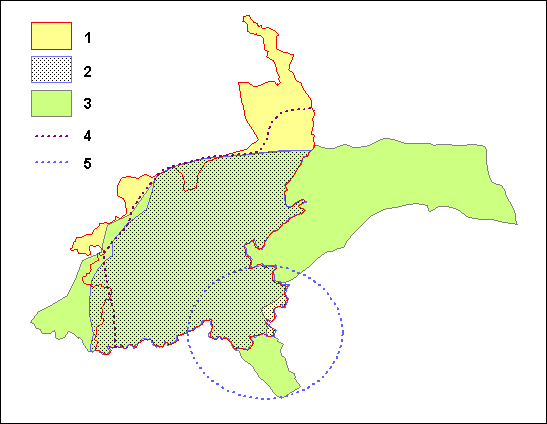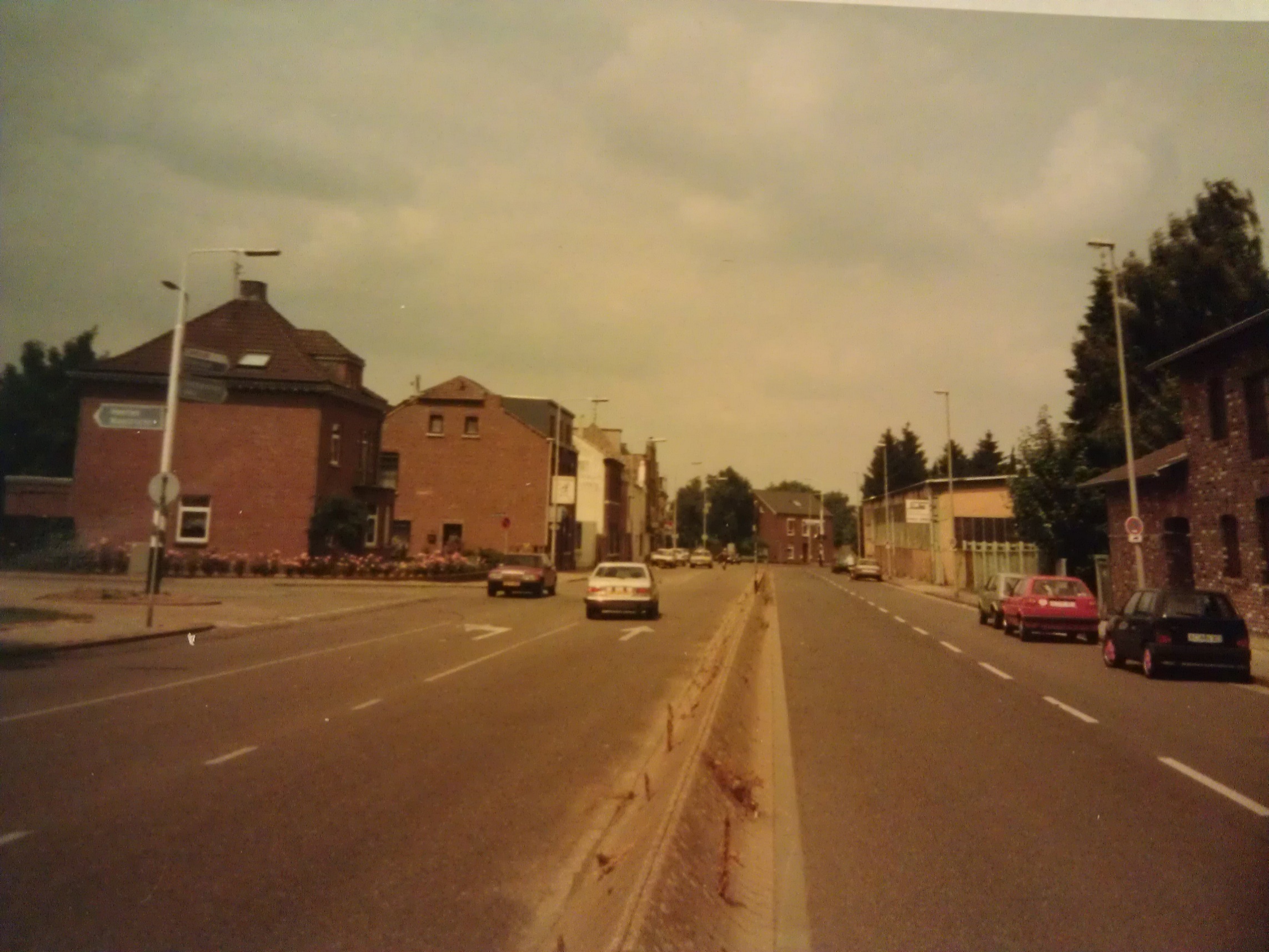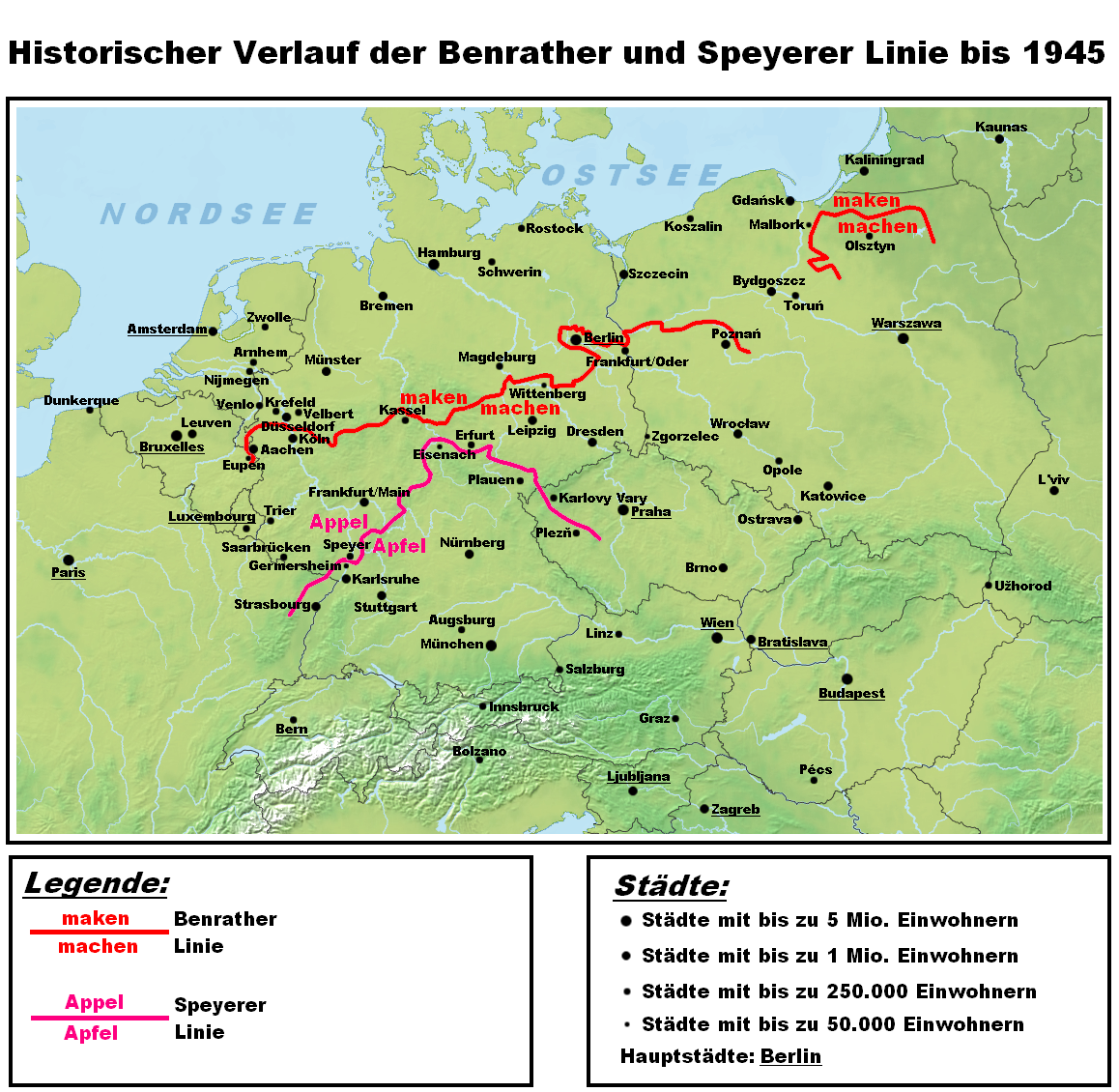|
Ripuarian Dialects
Ripuarian ( ; also ''Ripuarian Franconian''; german: Ripuarisch, , ''ripuarische Mundart, ripuarischer Dialekt, ripuarisch-fränkische Mundart, Ribuarisch'', nl, Ripuarisch , ''Noordmiddelfrankisch'') is a German dialect group, part of the West Central German language group. Together with the Moselle Franconian which includes the Luxembourgish language, Ripuarian belongs to the larger Central Franconian dialect family and also to the Rhinelandic linguistic continuum with the Low Franconian languages. It is spoken in the Rhineland south of the Benrath line — from northwest of Düsseldorf and Cologne to Aachen in the west and to Waldbröl in the east. The language area also comprises the north of the German-speaking Community of Belgium as well as the southern edge of the Limburg province of the Netherlands, especially Kerkrade (''Kirchroa''), where it is perceived as a variety of Limburgish and legally treated as such. The name derives from the Ripuarian Franks (''Rhein ... [...More Info...] [...Related Items...] OR: [Wikipedia] [Google] [Baidu] |
Germany
Germany,, officially the Federal Republic of Germany, is a country in Central Europe. It is the second most populous country in Europe after Russia, and the most populous member state of the European Union. Germany is situated between the Baltic and North seas to the north, and the Alps to the south; it covers an area of , with a population of almost 84 million within its 16 constituent states. Germany borders Denmark to the north, Poland and the Czech Republic to the east, Austria and Switzerland to the south, and France, Luxembourg, Belgium, and the Netherlands to the west. The nation's capital and most populous city is Berlin and its financial centre is Frankfurt; the largest urban area is the Ruhr. Various Germanic tribes have inhabited the northern parts of modern Germany since classical antiquity. A region named Germania was documented before AD 100. In 962, the Kingdom of Germany formed the bulk of the Holy Roman Empire. During the 16th ce ... [...More Info...] [...Related Items...] OR: [Wikipedia] [Google] [Baidu] |
Rhinelandic
Rhinelandic is a term occasionally used for linguistic varieties of a region on both sides of the Middle and Lower Rhine river in Central West Germany, Belgium, the Netherlands, and Luxembourg. It has at least two distinct meanings which often can only be determined from the fine grain context in which the term is used. (This could be complicated at times since in German publications, local languages of villages or cities are commonly referred to as "the dialects" or "dialect", whereas the regiolects, which are dialects of Low German or High German in a linguistic sense, are hardly called so, but referred to using terms like "Rhinelandic", "Hessian," or "Bavarian", etc., that also name large compounds of related local languages ) One of the meanings of ''Rhinelandic'' is that of a group of local languages in an area called the Rhineland. Another meaning is that of the regiolect being used by the people approximately of the same area. Rhinelandic Local Languages ''Rhinelandic'' ... [...More Info...] [...Related Items...] OR: [Wikipedia] [Google] [Baidu] |
Öcher Platt
Southeast Limburgish (Dutch: ''Zuidoost-Limburgs'', Ripuarian: ''Süüdoß-Limburjesch''), also referred to as Southern Meuse-Rhenish, is a subdivision of what recently has been named Meuse-Rhenish. Both terms denote a rather compact grouping of varieties spoken in the Limburg and Lower Rhineland regions, near the common Dutch/Flemish (Belgium) and Dutch/German borders. These dialectal varieties differ notably from Dutch and Flemish at the one side, and no less from German at the other. In the Netherlands and Belgium this group is often included in the generic term Limburgish. Limburgish was recently recognised as a regional language (''streektaal'') in the Netherlands and as such it receives moderate protection under chapter 2 of the European Charter for Regional or Minority Languages. The linguistic border of the Limburgish varieties to the South is the Benrath line, to the North it is the Uerdingen line. This means Southeast Limburgish is different in nature from the other Limb ... [...More Info...] [...Related Items...] OR: [Wikipedia] [Google] [Baidu] |
Ripuarian Franks
Ripuarian or Rhineland Franks (Latin: ''Ripuarii'' or ''Ribuarii'') were one of the two main groupings of early Frankish people, and specifically it was the name eventually applied to the tribes who settled in the old Roman territory of the Ubii, with its capital at Cologne on the Rhine river in modern Germany. Their western neighbours were the Salii, or "Salian Franks", who were named already in late Roman records, and settled with imperial permission within the Roman Empire in what is today the southern part of the Netherlands, and Belgium, and later expanded their influence into the northern part of France above the Loire river, creating the Frankish empire of Francia. Both the Salii and Ripuarii were new names and represented new groupings of older tribal groups on the Roman Rhine border. The ancestors of the Ripuarii originally lived on the right bank of the Rhine, where there had been a long history of friendly and unfriendly contact. Under pressure from their northern enemi ... [...More Info...] [...Related Items...] OR: [Wikipedia] [Google] [Baidu] |
Limburgish Language
Limburgish ( li, Limburgs or ; nl, Limburgs ; german: Limburgisch ; french: Limbourgeois ), also called Limburgan, Limburgian, or Limburgic, is a West Germanic language spoken in the Dutch and Belgian provinces of Limburg and in the neighbouring regions of Germany. It shares characteristics with both German and Dutch but has unique features such as tonality. Within the modern communities of the Belgian and Dutch provinces of Limburg, intermediate idiolects are also very common, which combine standard Dutch with the accent and some grammatical and pronunciation tendencies derived from Limburgish. This "Limburgish Dutch" is confusingly also often referred to simply as "Limburgish", although in Belgium such intermediate languages tend to be called ("in-between language"), no matter the exact dialect/language with which standard Dutch is combined. Although frequently misunderstood as such, Limburgish does not refer to the regional variation of Dutch spoken in Dutch Limburg ... [...More Info...] [...Related Items...] OR: [Wikipedia] [Google] [Baidu] |
Kerkrade
Kerkrade ( Ripuarian: ; li, Kirkraoj; german: Kerkrade or ''Kirchrath'') is a town and a municipality in the southeast of Limburg; the southernmost province of the Netherlands. It forms part of the Parkstad Limburg agglomeration. Kerkrade is the western half of a divided city; it was part of the German town of Herzogenrath until the Congress of Vienna in 1815 drew the current Dutch-German border and separated the towns.Jan Buursink and Nicole Ehlers"The Binational City of Eurode". University of Nijmegen. This means that the eastern end of the city marks the international border. The two towns, including outlying suburban settlements, have a population approaching 100,000, of which nearly 47,000 are in Kerkrade. History The history of Kerkrade is closely linked with that of the adjacent town of Herzogenrath, just across the German border. Herzogenrath began as a settlement, called Rode, near the river Worm (or Wurm in German) in the 11th century. In 1104 Augustinian monks founde ... [...More Info...] [...Related Items...] OR: [Wikipedia] [Google] [Baidu] |
German-speaking Community Of Belgium
The German-speaking Community (german: links=no, Deutschsprachige Gemeinschaft, or DG; french: links=no, Communauté germanophone; nl, links=no, Duitstalige Gemeenschap), since 2017 also known as East Belgium (german: links=no, Ostbelgien), is one of the three federal communities of Belgium. Covering an area of within the Liège Province in Wallonia, it includes nine of the eleven municipalities of Eupen-Malmedy. Traditionally speakers of Low Dietsch, Ripuarian, and Moselle Franconian varieties, the local population numbers 77,949about 7.0% of Liège Province and about 0.7% of the national total. Bordering the Netherlands, Germany and Luxembourg, the area has its own parliament and government at Eupen. The German-speaking Community of Belgium is composed of the German-speaking parts of the lands that were annexed in 1920 from Germany. In addition, in contemporary Belgium there are also some other areas where German is or has been spoken (the difference line between German, D ... [...More Info...] [...Related Items...] OR: [Wikipedia] [Google] [Baidu] |
Waldbröl
Waldbröl is a town in the southern part of the Oberbergischer Kreis (upper Berg county), in North Rhine-Westphalia, Germany. Geography Location The town is located on the slopes of the Nutscheid range of hills and is part of the Bergisches Land Nature Park. It is about east of the city of Cologne. Neighbouring municipalities The town of Waldbröl itself is much larger than the municipal centres of all its neighbouring municipalities and serves as their local shopping town and source of local services. Beginning with Reichshof in the North and moving on clockwise, the neighbouring municipalities are Morsbach, Windeck, Ruppichteroth and Nümbrecht. Municipal subdivisions In addition to Waldbröl itself, which has a population of about 11,000, there are 64 separate sub-districts: History In 1131, the place was mentioned for the first time, as Waltprugele in a papal deed of ownership for the St. Cassius abbey in Bonn. In this document Pope Innocent II confirmed the Church' ... [...More Info...] [...Related Items...] OR: [Wikipedia] [Google] [Baidu] |
Aachen
Aachen ( ; ; Aachen dialect: ''Oche'' ; French and traditional English: Aix-la-Chapelle; or ''Aquisgranum''; nl, Aken ; Polish: Akwizgran) is, with around 249,000 inhabitants, the 13th-largest city in North Rhine-Westphalia, and the 28th-largest city of Germany. It is the westernmost city in Germany, and borders Belgium and the Netherlands to the west, the triborder area. It is located between Maastricht (NL) and Liège (BE) in the west, and Bonn and Cologne in the east. The Wurm River flows through the city, and together with Mönchengladbach, Aachen is the only larger German city in the drainage basin of the Meuse. Aachen is the seat of the City Region Aachen (german: link=yes, Städteregion Aachen). Aachen developed from a Roman settlement and (bath complex), subsequently becoming the preferred medieval Imperial residence of Emperor Charlemagne of the Frankish Empire, and, from 936 to 1531, the place where 31 Holy Roman Emperors were crowned Kings of the Germans. ... [...More Info...] [...Related Items...] OR: [Wikipedia] [Google] [Baidu] |
Cologne
Cologne ( ; german: Köln ; ksh, Kölle ) is the largest city of the German western States of Germany, state of North Rhine-Westphalia (NRW) and the List of cities in Germany by population, fourth-most populous city of Germany with 1.1 million inhabitants in the city proper and 3.6 million people in the Cologne Bonn Region, urban region. Centered on the left bank of the Rhine, left (west) bank of the Rhine, Cologne is about southeast of NRW's state capital Düsseldorf and northwest of Bonn, the former capital of West Germany. The city's medieval Catholic Cologne Cathedral (), the third-tallest church and tallest cathedral in the world, constructed to house the Shrine of the Three Kings, is a globally recognized landmark and one of the most visited sights and pilgrimage destinations in Europe. The cityscape is further shaped by the Twelve Romanesque churches of Cologne, and Cologne is famous for Eau de Cologne, that has been produced in the city since 1709, and "col ... [...More Info...] [...Related Items...] OR: [Wikipedia] [Google] [Baidu] |
Düsseldorf
Düsseldorf ( , , ; often in English sources; Low Franconian and Ripuarian: ''Düsseldörp'' ; archaic nl, Dusseldorp ) is the capital city of North Rhine-Westphalia, the most populous state of Germany. It is the second-largest city in the state and the seventh-largest city in Germany, with a population of 617,280. Düsseldorf is located at the confluence of two rivers: the Rhine and the Düssel, a small tributary. The ''-dorf'' suffix means "village" in German (English cognate: ''thorp''); its use is unusual for a settlement as large as Düsseldorf. Most of the city lies on the right bank of the Rhine. Düsseldorf lies in the centre of both the Rhine-Ruhr and the Rhineland Metropolitan Region. It neighbours the Cologne Bonn Region to the south and the Ruhr to the north. It is the largest city in the German Low Franconian dialect area (closely related to Dutch). Mercer's 2012 Quality of Living survey ranked Düsseldorf the sixth most livable city in the world. Düsse ... [...More Info...] [...Related Items...] OR: [Wikipedia] [Google] [Baidu] |
Benrath Line
In German linguistics, the Benrath line (german: Benrather Linie) is the ''maken–machen'' isogloss: dialects north of the line have the original in ''maken'' (to make), while those to the south have the innovative (''machen''). The Line runs from Aachen in the west via Benrath (south of Düsseldorf) to eastern Germany near Frankfurt an der Oder in the area of Berlin and Dessau and through former East Prussia dividing Low Prussian dialect and High Prussian dialect. It is called Benrath line because Benrath is the place where it crosses the Rhine. The High German consonant shift (3rd to 9th centuries AD), in which the (northern) Low German dialects for the most part did not participate, affected the southern varieties of the West Germanic dialect continuum. This shift is traditionally seen to distinguish the High German varieties from the other West Germanic languages. The impact of the High German consonant shift increases gradually to the South. The Benrath line does not mar ... [...More Info...] [...Related Items...] OR: [Wikipedia] [Google] [Baidu] |








